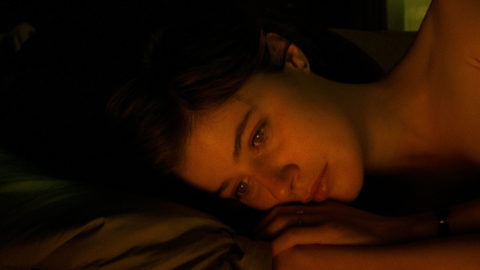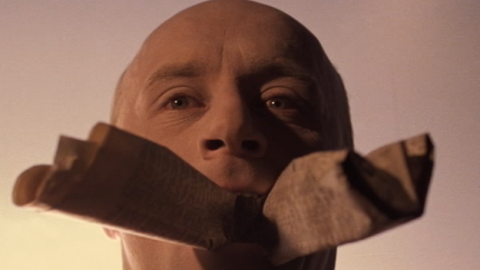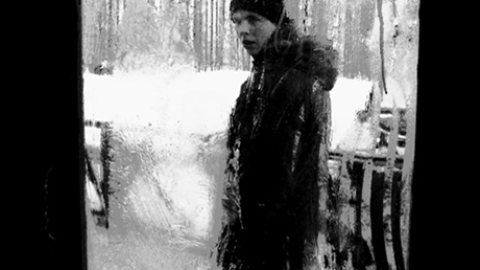Interview: Michal Marczak
Since his first feature, At the Edge of Russia (2010), Polish filmmaker Michał Marczak has ventured into ever more ambitious realms of hybrid documentary. Not all critics took kindly to Marczak’s tactic of staging much of the action in that movie, yet At the Edge of Russia won honors at Hot Docs, after playing at CPH:Dox and IDFA, and then had its American premiere at the True/False Film Festival. Shot at a remote northern military post, the film exhibits a winsome blend of poetry and adventure, much like Robert Flaherty’s Nanook of the North—a film that reminds us how staging and extensive collaboration with nonactors are as old as the documentary form itself.
Marczak took another decisive step in what might be called collaborative direction with Fuck for Forest (2012), a hybrid with a strong voyeuristic bend. Director-cinematographer Marczak makes his camera an active participant in happenings staged by young radical environmentalists who are determined to save the Amazon rainforest by making and selling pornography. The immersive approach feels particularly suited to the Internet- and media-savvy twentysomethings on screen, yet Marczak simultaneously signals that we aren’t meant to watch uncritically: he catches conflicts between family and friends, and quiet moments of disorientation, and loneliness.
With All These Sleepless Nights, Marczak captures this splintering vision again, netting a Best Director award last year at Sundance. Controversies over staging have not deterred Marczak; if anything, they have emboldened him. An all-hours daisy-chain chronicle of Warsaw partygoers focused on friends Michal and Chris, All These Sleepless Nights seduces us with its mysterious, magical personalities and narrative flourishes, to the point of seeming fictional. Michal’s falling madly in-and-out of love with a young woman is not only fraught with pain, but also tests his male friendship. On strobe-lit dance floors and against picturesque cityscapes, the nocturnal escapades may seem like an elaborate fantasy, yet are grounded in the real: Marczak filmed actual clubs and parties, and even the romance is inspired by past experience. The carefree reveries contrast with stark, lucid dawns, which hint at the young men’s sobering up into maturity.
Film Comment spoke to Marczak on the occasion of the Film Comment Selects screening of All These Sleepless Nights on Saturday, February 18, at the Film Society of Lincoln Center. The film will open in New York, Los Angeles and San Francisco on April 7.
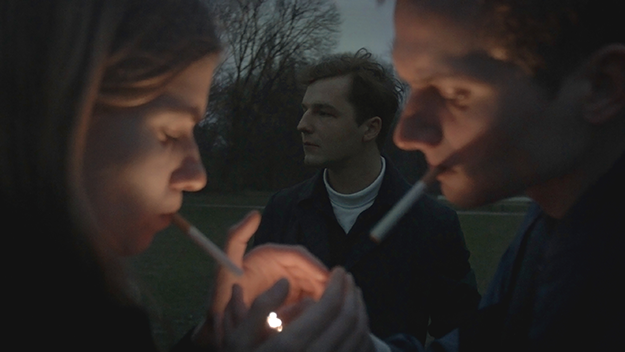
All These Sleepless Nights
Polish critic Tadeusz Sobolewski compared All These Sleepless Nights to Andrzej Wajda’s Innocent Sorcerers. Wajda’s film is about a very specific historical moment. I wonder if your film also has a historical, political dimension?
All These Sleepless Nights has no direct politics in it, but of course, in some ways, it’s a very political film. We’ve just had 25 years of steady growth in Poland. But when you think of it, [after WWII], we didn’t have freedom for over 50 years, and then when we finally did, it took us another 15 years to get on our feet.
My generation was an in-between one. Our identity was a mix of what we inherited from communism and then acquired from the West. It wasn’t very original. When I was 18, the country got flooded by Western products and culture. So many pillars of our own culture had collapsed: film, theater, the arts. Whereas the new generation has already gotten the hang of the new world order. They are completely free. The Warsaw clubs and the locations we filmed for All These Sleepless Nights all show that when you have freedom, you can focus on what you want to achieve.
While we were finishing the film, Poland’s political situation changed again [with the rise of a hard-right government]. We wanted to add a new context, at first, but then I thought that the anticipation wouldn’t feel quite real. No one really expected for changes to come so suddenly. We thought our freedom was only just beginning. I really hope that in 10 years from now there will be hope of getting back to that time, that kind of openness.
All These Sleepless Nights gained a new kind of recognition from the Cinema Eye Honors, called the Unforgettables, which acknowledges a special collaboration between filmmaker and subject. What did the young people in your film bring to it?
I looked for young people who were part of the Warsaw scene but were also outsiders. It was difficult, because most who take part in subcultures end up representing them completely. Michal and Chris [Krzysztof] struck me, because they have their own worlds. Both are performance art majors and students of Polish artist Miroslaw Balka. So much of art today is abstract, conceptual, but Balka’s students create performances based on simple emotional concepts (love, future, poetry). They are interested in living in the moment. All of that resonated with me immediately.
I find it very apt that Michal was nominated for the Unforgettables prize—he his own way of playing with language and seeing the world, his inner poetry.
I imagine that his being a performance major made him game for everything that you proposed.
Or that we proposed together. We were really a fit.
Considering he’s a performance artist, it seems you gave him a platform—I mean, here’s a film that, in a way, he made. Or is that going to far?
It might be, if you’re saying his persona is created. Of course, there’s always a question of performance, in any film. But I do think that Michal is being himself. Some artists, such as Wojciech Bakowski, have strongly created personas, but Michal is more of a natural. The situations that we created in the film brought forth some of his own qualities.
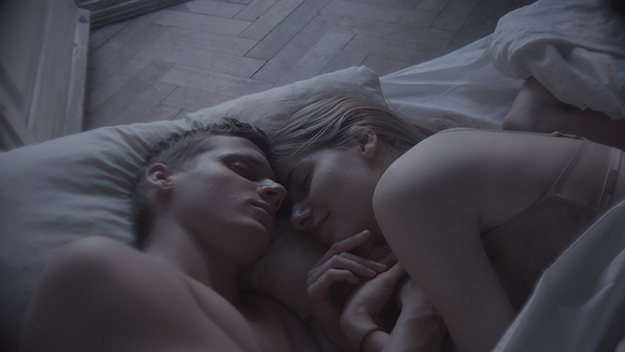
All These Sleepless Nights
Eva is another interesting person. She speaks with a foreign accent, which heightens the sense of her as an outsider.
Eva is a very intriguing person to come across in Poland. She is half French, half Polish. Her persona combines this super confident, strong young woman, who is in control of all situations, with her natural fragility, and even girlishness. That’s why she’s incredible at playing both roles. But when her two worlds collide, it becomes hard to reconcile them. That’s what I saw in her.
It seems like your being drawn to sensitive young people was already a theme in your previous film, Fuck for Forest.
I’m always drawn to people who want to figure out stuff by themselves. Also to positive individuality: not the selfish kind but rather one that makes people want to create a more integrated living. The young in Fuck for Forest want to create a new ecosystem. I think people always forget about the young people’s potential and only see what’s negative in their seeking. They forget that the world changes rapidly, and that the young absorb these changes. They have the power to impose new rules.
The intimacy and atmosphere in Fuck for Forest are incredible. What was the challenge for you in All These Sleepless Nights?
With Fuck for Forest, I really wanted you to feel that you’re entering the group. You’re living their drama and seeing the world through their eyes. In All These Sleepless Nights, I took it a step further. I pushed the cinematic aspect, so that this sensation is heightened even more. That’s why I used a fluid, dancing camera. A wide lens allowed me to stay close to people. I could literally touch them from behind the camera, and have physical contact. I do think you end up feeling that energy and closeness in the frame. Our being together, the flow, come through the camera, not just in the cinematic but also in an emotional way. When you are in that mindset on the set, you intuit where to place the camera by responding to those around you.
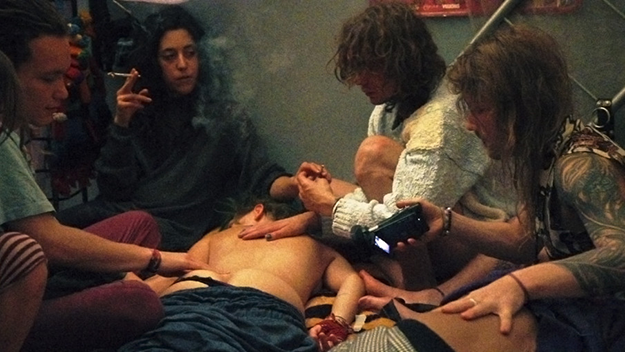
Fuck for Forest
You built special camera and lighting rigs for this film. How did this equipment affect the film?
I wanted a super light, mobile camera, so that I didn’t need to use any additional light, and could film mostly in natural lighting. We pre-lit very few of the club scenes, and then only before the shows. If we used lights, it was only regular ones, so that when people arrived at a party, it always felt natural. No film lights. I also built a rig, which was a combination of Steadicam and a gyroscope that let to focus and control the computer with both hands. This way, I was able to work with a very small crew, from beginning to end. We were all very connected; for example, my sound person was also my eyes. We figured things out together.
Instead of using direct sound from the shoots, you re-constructed each shot’s sound entirely afterward, from looping voices to adding ambient sound. Could you talk about that decision?
Someone once said, “It’s the eye that sees but the ear that imagines.” That’s why sound is super important. Dirty production sound can actually ruin your film’s atmosphere. But when you’re shooting at a party, and all of a sudden you turn down the music, because you need to shoot dialogue, it’s just unnatural. That’s why we recreated the sound later—instead of having a cacophony of sound, which our human ear actually filters out when we are in the moment.
Playing with the sound allowed us to do a lot of others things. We could use the track changes to modulate and structure our soundtrack. The changes in the background are all conceived to help the narrative along and to bring out emotions. We play with the audience’s emotions in a very subtle way.
So Michal, Chris and Eva re-recorded all their dialogue.
We had 60 people come back to the studio. Everybody, including crowds. We didn’t use any sound from stock. We would bring 20 people, and essentially throw a party, and record. If people drank originally in the scene, they’d drink. We rented a huge anechoic [echo-free] chamber from the Polytechnic University. The recreation took us over a month, because you have to create emotions from scratch, and of course, none of the people in the film are professional actors. It took a really long time to recover naturalness for each scene. We did a scene per day. You could say we stressed the documentary approach over the technical one.
So the result is performative, and yet intimate.
Absolutely. If you listened to the dialogue alone, you might find some of them slightly “off,” but that is not the point. As long as dialogues have an emotional charge, that’s what we want. Lip-syncing, of course, took hundreds of hours to edit, even with today’s technology, but this is less important than conveying emotions and mood. We also had an opportunity to recreate the flow—to heighten certain things and downplay others in the studio, to build the dramaturgy.
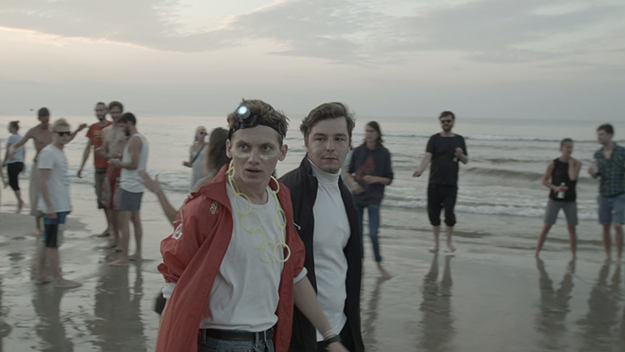
All These Sleepless Nights
The way you frame the film, it also feels like a reminiscence of a relationship that’s over. The story comes across as bittersweet, almost fatalistic.
That whole first part, where the film tracks back, is much more symbolic, almost naïve. It is structured like a memory, and memories turn idyllic with time. They lose texture and become one-sided. You remember what you most want to remember. The film made me look back at my memories, and it is a bit nostalgic to realize that we are left only with these tiny clouds of relationships that span so many days.
For a film about endless parties, it also conveys profound loneliness.
The film’s second part is very much about loneliness. First, there’s the discovery of freedom, when you leave your family, you can do whatever you want, and no one judges you. Then a certain time comes when that bliss fades away. There is loneliness, but also a moment of: “What now?” That’s what Michal says, in the end. He’s living through all these experiences, but has no clue yet what to do with them. Maybe that’s something we never figure out. Where do I go from now? There is also a sense that you will probably never experience things with quite the same intensity. I didn’t want to show what happens next for Michal. The audience has to fill in that part. But his way of living is done. Something new is approaching.
And what’s next in store for you?
I’m working on a science-fiction film about a man who claims to be an alien. The film will be shot partly in Poland, and since it’s fiction, it will most likely have professional actors in the lead roles. There’s a mystery in the film, as far as what’s true, what imaginary. I want to play with the idea of human consciousness.
Ela Bittencourt works as a critic and programmer in the U.S. and Brazil and is a member of the selection committee for It’s All True International Documentary Film Festival.



